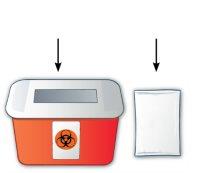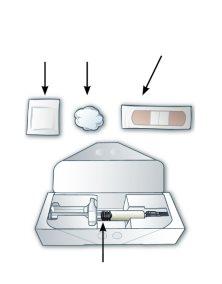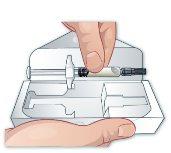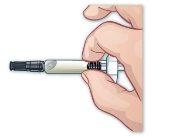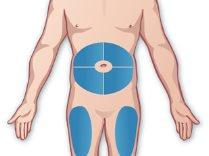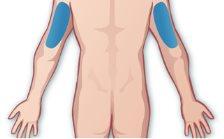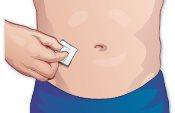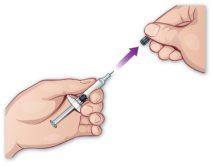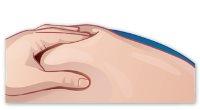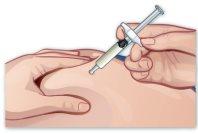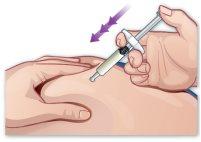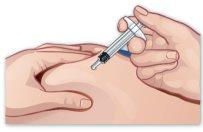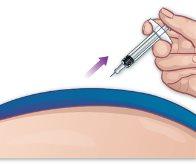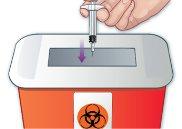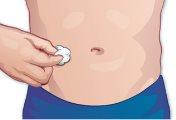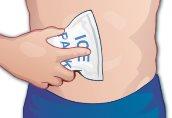
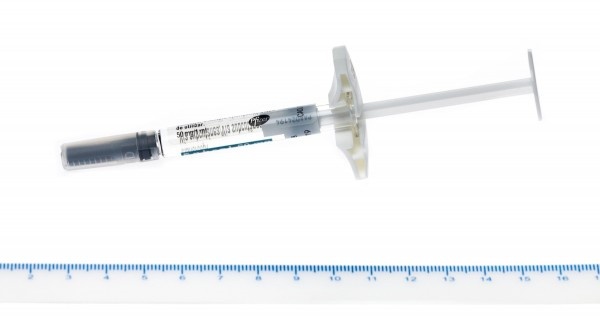
ВЭЙЛИВРА 285 мг РАСТВОР ДЛЯ ИНЪЕКЦИЙ В ПРЕДНАПОЛНЕННОМ ШПРИЦЕ

Спросите врача о рецепте на ВЭЙЛИВРА 285 мг РАСТВОР ДЛЯ ИНЪЕКЦИЙ В ПРЕДНАПОЛНЕННОМ ШПРИЦЕ

Инструкция по применению ВЭЙЛИВРА 285 мг РАСТВОР ДЛЯ ИНЪЕКЦИЙ В ПРЕДНАПОЛНЕННОМ ШПРИЦЕ
Введение
Инструкция: информация для пользователя
Waylivra 285 мг раствор для инъекций в предварительно заполненном шприце
воланесорсен
Этот препарат подлежит дополнительному мониторингу, который позволит быстро обнаружить новую информацию о его безопасности. Вы можете внести свой вклад, сообщая о побочных эффектах, которые у вас могут возникнуть. В конце раздела 4 содержится информация о том, как сообщать о этих побочных эффектах.
Прочитайте внимательно всю инструкцию перед началом использования этого препарата, поскольку она содержит важную информацию для вас.
- Сохраните эту инструкцию, поскольку вам может потребоваться прочитать ее снова.
- Если у вас есть какие-либо вопросы, проконсультируйтесь с вашим врачом, фармацевтом или медсестрой.
- Этот препарат назначен вам исключительно, и не следует передавать его другим людям, даже если у них такие же симптомы, как у вас, поскольку это может нанести им вред.
- Если вы испытываете побочные эффекты, проконсультируйтесь с вашим врачом, фармацевтом или медсестрой, даже если это побочные эффекты, которые не указаны в этой инструкции. См. раздел 4.
Содержание инструкции
- Что такое Waylivra и для чего он используется
- Что вам нужно знать перед началом использования Waylivra
- Как использовать Waylivra
- Возможные побочные эффекты
- Хранение Waylivra
- Содержание упаковки и дополнительная информация
1. Что такое Waylivra и для чего он используется
Waylivra содержит активное вещество воланесорсен, которое помогает лечить заболевание, называемое семейной хиломикронемией (СХМ). СХМ - это генетическое заболевание, которое приводит к аномально высоким уровням триглицеридов в крови. Это может привести к воспалению поджелудочной железы, которое очень болезненно. В сочетании с диетой, бедной жирами, Waylivra помогает снижать концентрацию триглицеридов в крови.
Возможно, вам назначат Waylivra после того, как вы принимали другие препараты для снижения уровня триглицеридов в крови, которые не имели достаточного эффекта.
Вы будете получать Waylivra только в том случае, если генетический тест подтвердит, что у вас СХМ, и если ваш риск панкреатита очень высок.
Во время лечения Waylivra вам необходимо продолжать соблюдать диету, бедную жирами, которую назначил ваш врач.
Этот препарат предназначен для пациентов в возрасте 18 лет и старше.
2. Что вам нужно знать перед началом использования Waylivra
Не используйте Waylivra:
- если вы аллергичны к воланесорсену или к любому другому компоненту этого препарата (перечисленному в разделе 6).
- если у вас есть тромбоцитопения, которая заключается в том, что у вас очень мало тромбоцитов в крови (менее 140 × 10^9/л). Вы можете заметить это, если у вас есть ранка, которая долго не заживает (более 5-6 минут для царапины на коже). Ваш врач проведет анализ, чтобы узнать об этом до начала лечения этим препаратом. Возможно, вы не знаете, что у вас это состояние или что его могло вызвать.
Если любая из этих ситуаций относится к вам, или если вы не уверены, проконсультируйтесь с вашим врачом, фармацевтом или медсестрой перед использованием Waylivra.
Предостережения и меры предосторожности
Проконсультируйтесь с вашим врачом, фармацевтом или медсестрой перед началом использования Waylivra, если у вас есть или были какие-либо из следующих медицинских проблем:
- Очень высокие уровни триглицеридов, но не из-за СХМ.
- Низкое количество тромбоцитов (тромбоцитопения), тип клеток крови, которые помогают крови свертываться; перед началом лечения этим препаратом ваш врач проведет анализ крови, чтобы измерить количество тромбоцитов в вашей крови.
- Проблемы с печенью или почками любого рода.
Анализ крови
До начала лечения этим препаратом ваш врач проведет анализ, чтобы измерить количество тромбоцитов и затем на регулярных интервалах, пока вы принимаете Waylivra, чтобы контролировать количество тромбоцитов.
Проконсультируйтесь с вашим врачом немедленно, если у вас есть какие-либо признаки, указывающие на низкое количество тромбоцитов, такие как необычное или длительное кровотечение, красные пятна на коже (петехии), неясные синяки, кровотечение, которое не останавливается, носовое кровотечение или если у вас есть жесткость в шее или сильная головная боль.
Ваш врач также может назначить анализ крови каждые 3 месяца, чтобы проверить, есть ли какие-либо проблемы с печенью. Проконсультируйтесь с вашим врачом немедленно, если у вас есть признаки повреждения печени, такие как желтуха кожи и глаз, боль или отек живота, головокружение, спутанность сознания или общее чувство недомогания.
Если необходимо, ваш врач может изменить частоту введения этого препарата или временно его прекратить. Возможно, потребуется проконсультироваться с врачом-специалистом по заболеваниям крови, чтобы определить, можете ли вы продолжать принимать Waylivra.
Анализ мочи
Ваш врач может назначить анализ мочи или крови каждые 3 месяца, чтобы контролировать состояние почек. Проконсультируйтесь с вашим врачом немедленно, если у вас есть признаки повреждения почек, такие как отеки на лодыжках, ногах и руках, уменьшение количества мочи, затруднение дыхания, головокружение, спутанность сознания или сильная усталость.
Диета
До начала лечения этим препаратом вам необходимо соблюдать диету, которая помогает снижать уровень триглицеридов в крови.
Важно продолжать эту диету, чтобы снижать триглицериды, пока вы принимаете Waylivra.
Дети и подростки
Не используйте Waylivra, если вам меньше 18 лет. Waylivra не был изучен у пациентов моложе 18 лет.
Другие препараты и Waylivra
Сообщите вашему врачу или фармацевту, если вы принимаете, недавно принимали или можете принять любой другой препарат. Важно, чтобы вы сообщили вашему врачу, если вы получаете лечение любым из следующих препаратов:
- Препараты, которые предотвращают образование кровяных сгустков, например, ацетилсалициловая кислота, дипиридамол или варфарин.
- Другие препараты, которые могут изменить свертываемость крови, такие как нестероидные противовоспалительные препараты, например, ибупрофен, препараты, которые используются для предотвращения инфаркта миокарда и инсульта, такие как клопидогрел, тикагрелор и прасугрел, антибиотики, такие как пенициллин, препараты, такие как ранитидин (который используется для снижения кислотности желудка) и хинин (который используется для лечения малярии).
- Препараты, которые могут вызывать проблемы с печенью, такие как парацетамол.
Использование Waylivra с алкоголем
Неизвестен эффект использования Waylivra с алкоголем. Вы должны избегать употребления алкоголя во время лечения этим препаратом из-за риска проблем с печенью.
Беременность и лактация
Если вы беременны или кормите грудью, считаете, что можете быть беременной или планируете стать беременной, проконсультируйтесь с вашим врачом или фармацевтом перед использованием этого препарата. Предпочтительно избегать использования Waylivra во время беременности.
Вождение и использование машин
Мало вероятно, что Waylivra повлияет на вашу способность управлять транспортными средствами или использовать машины.
Waylivra содержит натрий
Этот препарат содержит менее 1 ммоль натрия (23 мг) на дозу; это означает, что он практически не содержит натрия.
3. Как использовать Waylivra
Следуйте точно инструкциям по введению этого препарата, указанным вашим врачом. В случае сомнений проконсультируйтесь с вашим врачом или фармацевтом снова.
До введения этого препарата ваш врач должен исключить другие причины повышения триглицеридов, такие как диабет или проблемы с щитовидной железой.
Ваш врач укажет, с какой частотой необходимо вводить этот препарат. Он может изменить частоту введения или попросить вас прекратить лечение на некоторое время или навсегда, в зависимости от результатов анализов крови и мочи или появления побочных эффектов.
Вам (или вашему опекуну) будет показано, как использовать Waylivra, следуя инструкциям этого руководства. Waylivra должен быть введен под кожу (подкожно, или СС) так, как показал ваш врач, медсестра или фармацевт, и проверено, что вся жидкость из шприца была введена. Каждый предварительно заполненный шприц с единичной дозой этого препарата вводит дозу 285 мг в 1,5 мл.
До использования этого препарата важно, чтобы вы прочитали, поняли и точно следовали инструкциям по введению.
Инструкции по использованию приведены в конце этого руководства.
Если вы использовали больше Waylivra, чем должно быть
Если вы ввели слишком много Waylivra, свяжитесь с вашим врачом или фармацевтом или обратитесь за экстренной помощью немедленно, даже если у вас нет симптомов.
Если вы забыли использовать Waylivra
Не принимайте двойную дозу, чтобы компенсировать пропущенные дозы. Если вы забыли принять дозу и вспомнили об этом до того, как прошло 48 часов с момента запланированного введения, примите пропущенную дозу как можно скорее. Но если прошло более 48 часов, вам следует ждать следующего запланированного введения. Не следует вводить более одной дозы в течение 2 дней.
Если вы прекратите лечение Waylivra
Не прекращайте использование Waylivra без предварительной консультации с вашим врачом.
Если у вас есть какие-либо другие вопросы о использовании этого препарата, проконсультируйтесь с вашим врачом, фармацевтом или медсестрой.
4. Возможные побочные эффекты
Как и все препараты, этот препарат может вызывать побочные эффекты, хотя не все люди испытывают их.
Серьезные побочные эффекты
Если у вас出现ит любой из следующих побочных эффектов, свяжитесь с вашим врачом немедленно:
- Симптомы, которые могут указывать на то, что количество тромбоцитов в крови низкое (тромбоциты - это клетки, важные для свертывания крови). Проконсультируйтесь с вашим врачом немедленно, если у вас есть признаки низкого количества тромбоцитов, такие как необычное или длительное кровотечение, появление красных пятен на коже (петехии), неясные синяки, кровотечение, которое не останавливается, носовое кровотечение или если у вас есть жесткость в шее или сильная головная боль.
Другие побочные эффекты
Очень часто(могут возникать у более 1 из 10 человек)
- Реакции в месте инъекции (сыпь, боль, покраснение, тепло, сухость, отек, зуд, онемение, уплотнение, крапивница, пузырьки, гранулы, гематома, кровотечение, онемение, бледность, изменение цвета или ощущение жжения в месте инъекции). Вы можете снизить вероятность возникновения реакции в месте инъекции, если подождете, пока Waylivra достигнет комнатной температуры, прежде чем вводить ее, и нанесете лед на место инъекции после этого.
- Головная боль
- Боль в мышцах
- Озноб
Часто(могут возникать у до 1 из 10 человек)
- Аномально высокие уровни лейкоцитов в анализах крови
- Аномально низкие уровни лейкоцитов (что известно как лимфопения) в анализах крови
- Легкость образования синяков или избыточное их количество, или появление синяков без видимой причины
- Кровотечение под кожей, которое выглядит как сыпь, кровотечение из десен или рта, наличие крови в моче или кале, носовое кровотечение или наличие слишком обильных месячных
- Аллергическая реакция, симптомы которой могут быть сыпь, скованность суставов или лихорадка
- Наличие крови или белка в моче
- Изменения в результатах определенных анализов крови, таких как:
- увеличение уровня некоторых компонентов крови: креатинина, мочевины, трансаминаз, печеночных ферментов
- увеличение времени свертывания
- снижение концентрации гемоглобина в крови
- снижение скорости фильтрации крови в почках
- Сахарный диабет, симптомы которого могут быть увеличением жажды, частым мочеиспусканием (особенно ночью), сильным голодом, сильной усталостью и непонятной потерей веса
- Трудности со сном
- Онемение, покалывание или жжение, ощущение обморока или обморока, головокружение или беспокойство
- Расстройства зрения, такие как видение вспышек или кратковременная слепота в одном глазу, кровотечение под поверхностью глаза или размытое зрение
- Высокое кровяное давление
- Жар, усиление потоотделения, ночная потливость, ощущение жара, болезнь, похожая на грипп, или общее чувство недомогания
- Кашель, затруднение дыхания, заложенность носа, отек горла, свистящее дыхание
- Чувство болезни, сухость во рту, диарея, отек шеи, лица или десен, боль или воспаление желудка, изжога
- Покраснение кожи, сыпь, прыщи, утолщение или появление рубцов или зуд кожи, известный как крапивница
- Боль в руках или ногах, боль в крупных суставах рук и ног, включая локти, запястья, колени и голени, другой тип боли или скованности суставов, боль в спине, боль в шее, боль в челюсти, мышечные спазмы или другие боли в теле
- Сильная усталость, слабость или отсутствие энергии, задержка жидкости, боль в груди, не связанная с сердцем.
Сообщение о побочных эффектах
Если вы испытываете любой побочный эффект, проконсультируйтесь с вашим врачом, фармацевтом или медсестрой, даже если это возможные побочные эффекты, которые не указаны в этом руководстве. Вы также можете сообщить о них напрямую через систему мониторинга безопасности лекарственных средств для человека: www.notificaRAM.es. Сообщая о побочных эффектах, вы можете внести свой вклад в предоставление более полной информации о безопасности этого препарата.
5. Хранение Waylivra
Храните этот препарат в недоступном для детей месте.
Не используйте этот препарат после даты истечения срока годности, указанной на упаковке и этикетке шприца после «EXP». Дата истечения срока годности - последний день месяца, указанного.
Храните в холодильнике (при температуре от 2 °C до 8 °C).
Храните в оригинальной упаковке, чтобы защитить от света.
Waylivra может находиться при комнатной температуре (до 30 °C) в оригинальной упаковке в течение 6 недель после извлечения из холодильника. В течение этого времени, по мере необходимости, этот препарат может находиться при комнатной температуре или в холодильнике. Запишите дату, когда вы впервые извлекли упаковку из холодильника, в указанном месте на упаковке. Если вы не используете этот препарат в течение 6 недель после первого извлечения из холодильника, утилизируйте препарат. Если во время 6-недельного периода, в течение которого шприц может находиться при комнатной температуре, истечет срок годности, указанный на этикетке, не используйте шприц и утилизируйте его.
Не используйте этот препарат, если вы заметили, что раствор мутный или содержит частицы, он должен быть прозрачным и бесцветным или иметь светло-желтый цвет.
Лекарства не должны выбрасываться в канализацию или мусор. Спросите вашего фармацевта, как утилизировать упаковку и лекарства, которые вам больше не нужны. Таким образом, вы поможете защитить окружающую среду.
6. Содержание упаковки и дополнительная информация
Состав Вайливры
- Активное вещество - воланесорсен. Каждый мл содержит 200 мг воланесорсена натрия, эквивалентного 190 мг воланесорсена. Каждая предзагруженная шприц-инъектор содержит 285 мг воланесорсена в 1,5 мл раствора.
- Другие компоненты - вода для инъекций, гидроксид натрия и соляная кислота (для регулирования кислотности, см. раздел 2, «Натрий»).
Внешний вид продукта и содержание упаковки
Вайливра выпускается в упаковке, содержащей шприц-инъектор однократного использования с иглой и защитным колпачком, предзагруженный прозрачным раствором от бесцветного до светло-желтого цвета. Предназначен для введения 1,5 мл раствора при полном нажатии на поршень шприца.
Продаётся в упаковке с одним предзагруженным шприц-инъектором или в многодозовой упаковке с 4 (4 упаковки по 1 шприцу) предзагруженными шприц-инъекторами.
Владелец разрешения на маркетинг
Akcea Therapeutics Ireland Ltd.
St. James House
72 Adelaide Road, Dublin 2
D02 Y017
Ирландия
Производитель
Almac Pharma Services Ireland Ltd.
Finnabair Industrial Estate
Dundalk
Co. Louth
Ирландия
Дата последнего пересмотра этой инструкции: 11/2022
Это лекарство было разрешено с «условным разрешением». Этот тип разрешения означает, что ожидается получение дополнительной информации о этом лекарстве.
Европейское агентство по лекарственным средствам будет пересматривать новую информацию о этом лекарстве至少 один раз в год, и эта инструкция или резюме характеристик продукта будет обновляться при необходимости.
Другие источники информации
Подробная информация о этом лекарстве доступна на сайте Европейского агентства по лекарственным средствам: http://www.ema.europa.eu.
Инструкции по применению
Вайливра - это инъекция, вводимая под кожу с помощью предзагруженного шприц-инъектора однократного использования.
Не используйте Вайливру, пока не поймёте хорошо процедуру, описанную ниже. Если у вас есть какие-либо вопросы о применении Вайливры, обратитесь к вашему врачу или фармацевту.
Части предзагруженного шприц-инъектора



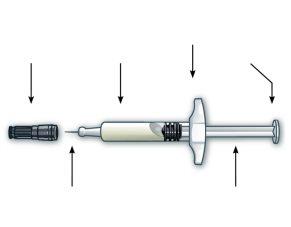
Подготовка к инъекции
- Вымойте руки и соберите необходимое для инъекции
Вымойте руки тщательно с мылом (не менее 3 минут) и высушите их хорошо.
Положите следующие предметы на плоскую, чистую поверхность в хорошо освещённом месте (Рисунок А).

|
|
Рисунок А
- Дайте инъекции достичь комнатной температуры
Если шприц-инъектор находится в холодильнике, дайте ему достичь комнатной температуры, вынув его из холодильника не менее чем за 30 минут до инъекции. Если вводимая жидкость холодная, она может вызвать реакции в месте инъекции, такие как боль, покраснение или отёк. Ненагревайте шприц-инъектор каким-либо другим способом, ни в микроволновой печи, ни с помощью горячей воды. |
Рисунок Б |
- Проверьте срок годности
Проверьте срок годности на упаковке. Срок годности, указанный на упаковке, относится к сроку жизни лекарства при хранении в холодильнике. В первый раз, когда вы вынимаете упаковку из холодильника, вам следует записать дату в указанном месте на упаковке. Неиспользуйте Вайливру, если срок годности истёк или если она находилась при комнатной температуре более 6 недель. Обратитесь к вашему врачу или фармацевту, чтобы получить новое лекарство. |
- Выньте шприц-инъектор и осмотрите лекарство
Откройте упаковку и выньте шприц-инъектор, держа его за цилиндр и вынимая его (Рисунок В). |
Рисунок В |
Осмотрите жидкость в шприце-инъекторе. Она должна быть прозрачной или иметь светло-жёлтый цвет. Нормально видеть большую воздушную пузырь (Рисунок Г). Непытайтесь удалить пузырь перед инъекцией. Ничего страшного, если вводить раствор с пузырьком. Неиспользуйте предзагруженный шприц-инъектор, если жидкость выглядит мутной или если есть плавающие частицы. |
Рисунок Г |
- Выберите место инъекции
Если вы будете вводить самостоятельно: Живот - показаны области живота, за исключением 5 см вокруг пупка. Бёдра - показаны передняя и средняя части (Рисунок Д). |
Рисунок Д |
Если инъекцию будет вводить помощник, кроме этих двух областей, можно вводить в: Руки - задняя часть руки, как показано (Рисунок Е). Для всех инъекций: Чередуйте места инъекций. Избегайте инъекций в области талии: одежда может тереться или давить на место инъекции. Не вводитев татуировки, родинки, шрамы, родимые пятна, синяки, высыпания или болезненные при прикосновении, покрасневшие, твёрдые, повреждённые, обожжённые или воспалённые участки кожи. Если вы не уверены, где следует вводить инъекцию, проконсультируйтесь с вашим медицинским специалистом. |
Рисунок Е |
Инъекция
- Подготовьте место инъекции
Очистите выбранное место ватной палочкой, смоченной в спирте (Рисунок Ж). |
Рисунок Ж |
- Снимите защитный колпачок с шприца-инъектора
Снимите защитный колпачок с шприца-инъектора, держа цилиндр шприца-инъектора так, чтобы игла не указывала на вас, и вынимая колпачок резким движением (Рисунок З). Возможно, на кончике иглы будет небольшая капля жидкости. Это нормально. Недержите поршень или его опору при снятии защитного колпачка. Неиспользуйте предзагруженный шприц-инъектор, если игла кажется повреждённой. Неиспользуйте предзагруженный шприц-инъектор, если он упадёт после снятия защитного колпачка. |
Рисунок З |
- Зажмите кожу
Зажмите кожу вокруг места инъекции свободной рукой (Рисунок И). |
Рисунок И |
- Вставьте иглу
Вставьте иглу в место инъекции быстрым и твёрдым движением, не касаясь опоры поршня. Игла должна быть введена под углом 45 градусов к поверхности кожи (Рисунок К). |
Рисунок К |
- Введение Вайливры
Введение жидкости, держа шприц-инъектор большим пальцем на поршне, и медленнонажимая его до конца его хода, пока шприц-инъектор не будет полностью пуст (Рисунки Л и М). |
Рисунок Л |
Рисунок М |
- Удалите иглу
Удалите иглу из места инъекции, вынимая её под тем же углом, под которым она была введена (Рисунок Н). |
Рисунок Н |
После инъекции
- Утилизируйте использованный шприц-инъектор в контейнер для острых предметов
Немедленно после инъекции утилизируйте использованный шприц-инъектор так, как указал ваш медицинский специалист, обычно в контейнеры для утилизации острых предметов (Рисунок О) следующим образом. Удалите защитный колпачок после инъекции. Ненакрывайте шприц-инъектор снова. Если у вас нет контейнера для утилизации острых предметов, вы можете утилизировать его в домашний контейнер, если:
|
Рисунок О |
Когда контейнер для утилизации острых предметов почти заполнен, вам следует следовать местным рекомендациям для безопасной утилизации. Могут быть местные правила, касающиеся утилизации использованных игл и шприцев. Спросите у вашего фармацевта или посетите сайт местных органов здравоохранения (если применимо), чтобы узнать больше о том, как утилизировать острые предметы в вашем регионе. Неутилизируйте контейнер для острых предметов в мусор. Неперерабатывайте использованный контейнер для острых предметов. Всегдадержите контейнер для острых предметов вне досягаемости детей и домашних животных. |
- Лечение места инъекции
Если из места инъекции вытекает кровь, слегка нажмите на это место стерильной ватной палочкой или марлей, если необходимо (Рисунок П). Нетрите место инъекции после введения. |
Рисунок П |
Вы также можете нанести лёд на место инъекции, чтобы уменьшить боль, покраснение или дискомфорт (Рисунок Р). |
Рисунок Р |
Хранение
Информация о хранении
Первый раз, когда вам дадут Вайливру, храните предзагруженные шприцы-инъекторы в упаковке в холодильнике (при температуре между 2 °C и 8 °C). Вайливра может храниться при комнатной температуре (между 8 °C и 30 °C) в упаковке, защищённой от света, не более 6 недель. В течение этих 6 недель это лекарство можно хранить при комнатной температуре или в холодильнике. Незамораживайте предзагруженный шприц-инъектор Вайливры. Невынимайте его из упаковки и не снимайте защитный колпачок до тех пор, пока не будете готовы к инъекции. Утилизируйте это лекарство немедленно, если оно не было использовано в течение 6 недель после первого вынимания из холодильника. Чтобы быть уверенным, проверьте дату, которую вы записали на упаковке. |
- Страна регистрации
- Активное вещество
- Требуется рецептДа
- Производитель
- Информация носит справочный характер и не является медицинской рекомендацией. Перед приемом любых препаратов проконсультируйтесь с врачом. Oladoctor не несет ответственности за медицинские решения, принятые на основе этого контента.
- Аналоги ВЭЙЛИВРА 285 мг РАСТВОР ДЛЯ ИНЪЕКЦИЙ В ПРЕДНАПОЛНЕННОМ ШПРИЦЕФорма выпуска: ТАБЛЕТКА, 10 мг эзетимибаАктивное вещество: эзетимибаПроизводитель: Organon Salud S.L.Требуется рецептФорма выпуска: КАПСУЛА, 1000 мгАктивное вещество: omega-3-triglycerides incl. other esters and acidsПроизводитель: Kern Pharma S.L.Требуется рецептФорма выпуска: КАПСУЛА, 1000 мгАктивное вещество: omega-3-triglycerides incl. other esters and acidsПроизводитель: Strides Pharma (Cyprus) LimitedТребуется рецепт
Аналоги ВЭЙЛИВРА 285 мг РАСТВОР ДЛЯ ИНЪЕКЦИЙ В ПРЕДНАПОЛНЕННОМ ШПРИЦЕ в других странах
Лучшие аналоги с тем же действующим веществом и терапевтическим эффектом.
Аналог ВЭЙЛИВРА 285 мг РАСТВОР ДЛЯ ИНЪЕКЦИЙ В ПРЕДНАПОЛНЕННОМ ШПРИЦЕ в Ucrania
Врачи онлайн по ВЭЙЛИВРА 285 мг РАСТВОР ДЛЯ ИНЪЕКЦИЙ В ПРЕДНАПОЛНЕННОМ ШПРИЦЕ
Консультация по дозировке, побочным эффектам, взаимодействиям, противопоказаниям и продлению рецепта на ВЭЙЛИВРА 285 мг РАСТВОР ДЛЯ ИНЪЕКЦИЙ В ПРЕДНАПОЛНЕННОМ ШПРИЦЕ – по решению врача и с учетом местных правил.








